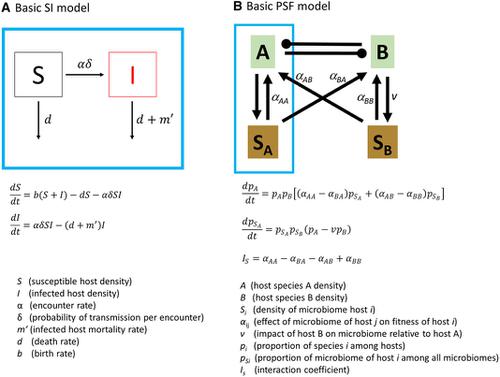当前位置:
X-MOL 学术
›
Ann. N. Y. Acad. Sci.
›
论文详情
Our official English website, www.x-mol.net, welcomes your feedback! (Note: you will need to create a separate account there.)
Community context for mechanisms of disease dilution: insights from linking epidemiology and plant–soil feedback theory
Annals of the New York Academy of Sciences ( IF 5.2 ) Pub Date : 2020-03-13 , DOI: 10.1111/nyas.14325 Cathy D Collins 1 , James D Bever 2, 3 , Michelle H Hersh 4
Annals of the New York Academy of Sciences ( IF 5.2 ) Pub Date : 2020-03-13 , DOI: 10.1111/nyas.14325 Cathy D Collins 1 , James D Bever 2, 3 , Michelle H Hersh 4
Affiliation

|
In many natural systems, diverse host communities can reduce disease risk, though less is known about the mechanisms driving this “dilution effect.” We relate feedback theory, which focuses on pathogen‐mediated coexistence, to mechanisms of dilution derived from epidemiological models, with the central goal of gaining insights into host–pathogen interactions in a community context. We first compare the origin, structure, and application of epidemiological and feedback models. We then explore the mechanisms of dilution, which are grounded in single‐pathogen, single‐host epidemiological models, from the perspective of feedback theory. We also draw on feedback theory to examine how coinfecting pathogens, and pathogens that vary along a host specialist–generalist continuum, apply to dilution theory. By identifying synergies among the feedback and epidemiological approaches, we reveal ways in which organisms occupying different trophic levels contribute to diversity–disease relationships. Additionally, using feedbacks to distinguish dilution in disease incidence from dilution in the net effect of disease on host fitness allows us to articulate conditions under which definitions of dilution may not align. After ascribing dilution mechanisms to macro‐ or microorganisms, we propose ways in which each contributes to diversity–disease and productivity–diversity relationships. Our analyses lead to predictions that can guide future research efforts.
中文翻译:

疾病稀释机制的社区背景:来自流行病学和植物-土壤反馈理论的见解
在许多自然系统中,不同的宿主社区可以降低疾病风险,但人们对推动这种“稀释效应”的机制知之甚少。我们将关注病原体介导的共存的反馈理论与源自流行病学模型的稀释机制联系起来,其中心目标是深入了解社区环境中的宿主 - 病原体相互作用。我们首先比较流行病学和反馈模型的起源、结构和应用。然后,我们从反馈理论的角度探讨了稀释机制,这些机制基于单一病原体、单一宿主的流行病学模型。我们还利用反馈理论来研究共同感染病原体以及沿着宿主专家-通才连续体变化的病原体如何应用于稀释理论。通过确定反馈和流行病学方法之间的协同作用,我们揭示了占据不同营养水平的生物体对多样性-疾病关系的贡献方式。此外,使用反馈来区分疾病发病率的稀释和疾病对宿主健康的净影响的稀释,使我们能够阐明稀释定义可能不一致的条件。在将稀释机制归因于宏观或微生物之后,我们提出了每种方法都有助于多样性-疾病和生产力-多样性关系的方法。我们的分析得出的预测可以指导未来的研究工作。使用反馈来区分疾病发病率的稀释和疾病对宿主健康的净影响的稀释,使我们能够阐明稀释定义可能不一致的条件。在将稀释机制归因于宏观或微生物之后,我们提出了每种方法都有助于多样性-疾病和生产力-多样性关系的方法。我们的分析得出的预测可以指导未来的研究工作。使用反馈来区分疾病发病率的稀释和疾病对宿主健康的净影响的稀释,使我们能够阐明稀释定义可能不一致的条件。在将稀释机制归因于宏观或微生物之后,我们提出了每种方法都有助于多样性-疾病和生产力-多样性关系的方法。我们的分析得出的预测可以指导未来的研究工作。
更新日期:2020-03-13
中文翻译:

疾病稀释机制的社区背景:来自流行病学和植物-土壤反馈理论的见解
在许多自然系统中,不同的宿主社区可以降低疾病风险,但人们对推动这种“稀释效应”的机制知之甚少。我们将关注病原体介导的共存的反馈理论与源自流行病学模型的稀释机制联系起来,其中心目标是深入了解社区环境中的宿主 - 病原体相互作用。我们首先比较流行病学和反馈模型的起源、结构和应用。然后,我们从反馈理论的角度探讨了稀释机制,这些机制基于单一病原体、单一宿主的流行病学模型。我们还利用反馈理论来研究共同感染病原体以及沿着宿主专家-通才连续体变化的病原体如何应用于稀释理论。通过确定反馈和流行病学方法之间的协同作用,我们揭示了占据不同营养水平的生物体对多样性-疾病关系的贡献方式。此外,使用反馈来区分疾病发病率的稀释和疾病对宿主健康的净影响的稀释,使我们能够阐明稀释定义可能不一致的条件。在将稀释机制归因于宏观或微生物之后,我们提出了每种方法都有助于多样性-疾病和生产力-多样性关系的方法。我们的分析得出的预测可以指导未来的研究工作。使用反馈来区分疾病发病率的稀释和疾病对宿主健康的净影响的稀释,使我们能够阐明稀释定义可能不一致的条件。在将稀释机制归因于宏观或微生物之后,我们提出了每种方法都有助于多样性-疾病和生产力-多样性关系的方法。我们的分析得出的预测可以指导未来的研究工作。使用反馈来区分疾病发病率的稀释和疾病对宿主健康的净影响的稀释,使我们能够阐明稀释定义可能不一致的条件。在将稀释机制归因于宏观或微生物之后,我们提出了每种方法都有助于多样性-疾病和生产力-多样性关系的方法。我们的分析得出的预测可以指导未来的研究工作。



























 京公网安备 11010802027423号
京公网安备 11010802027423号